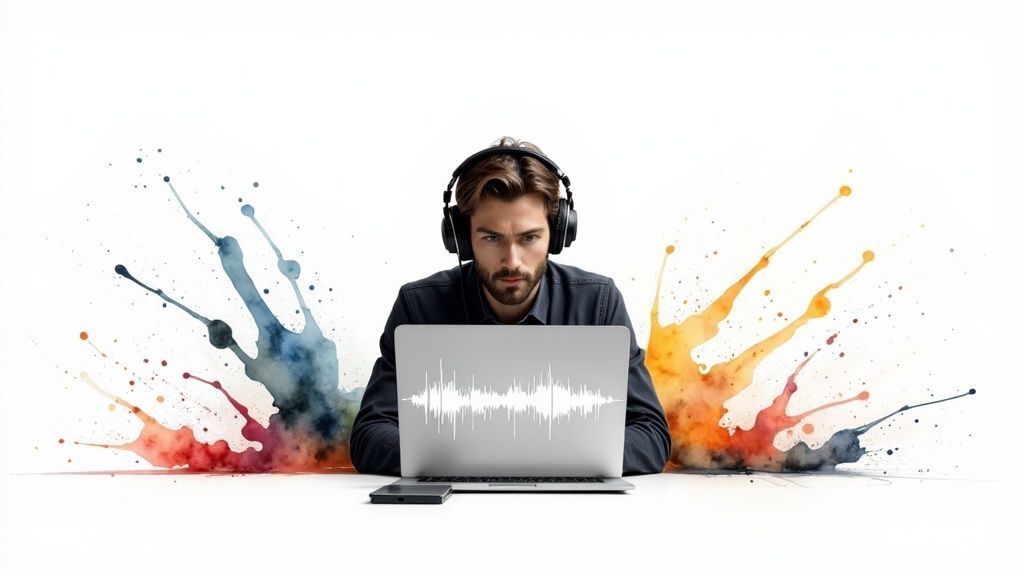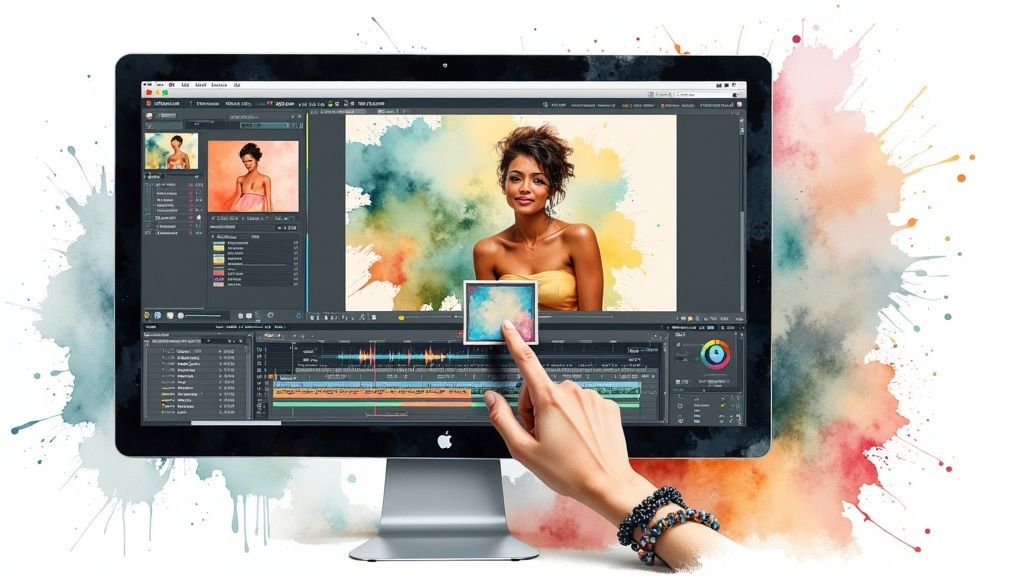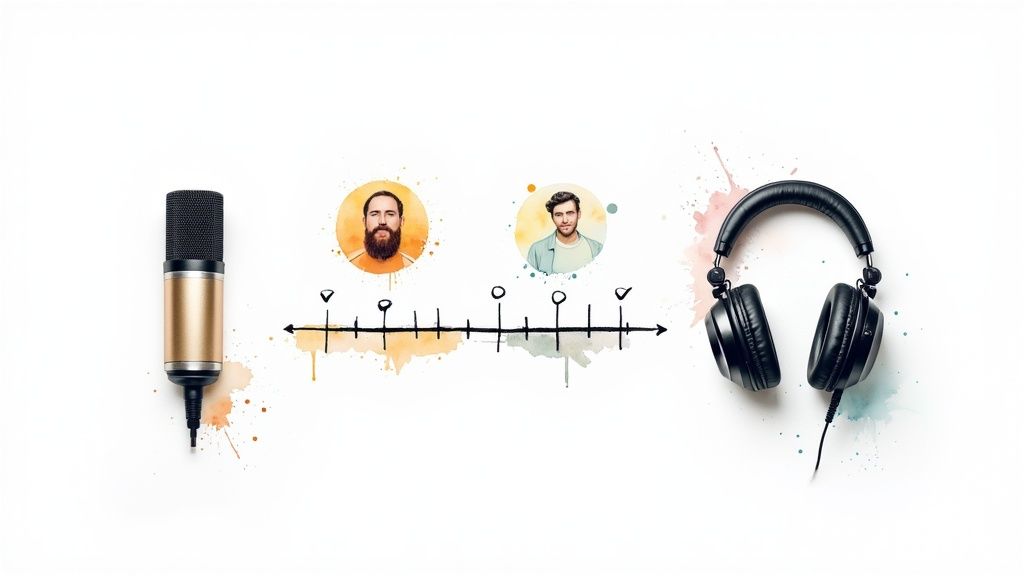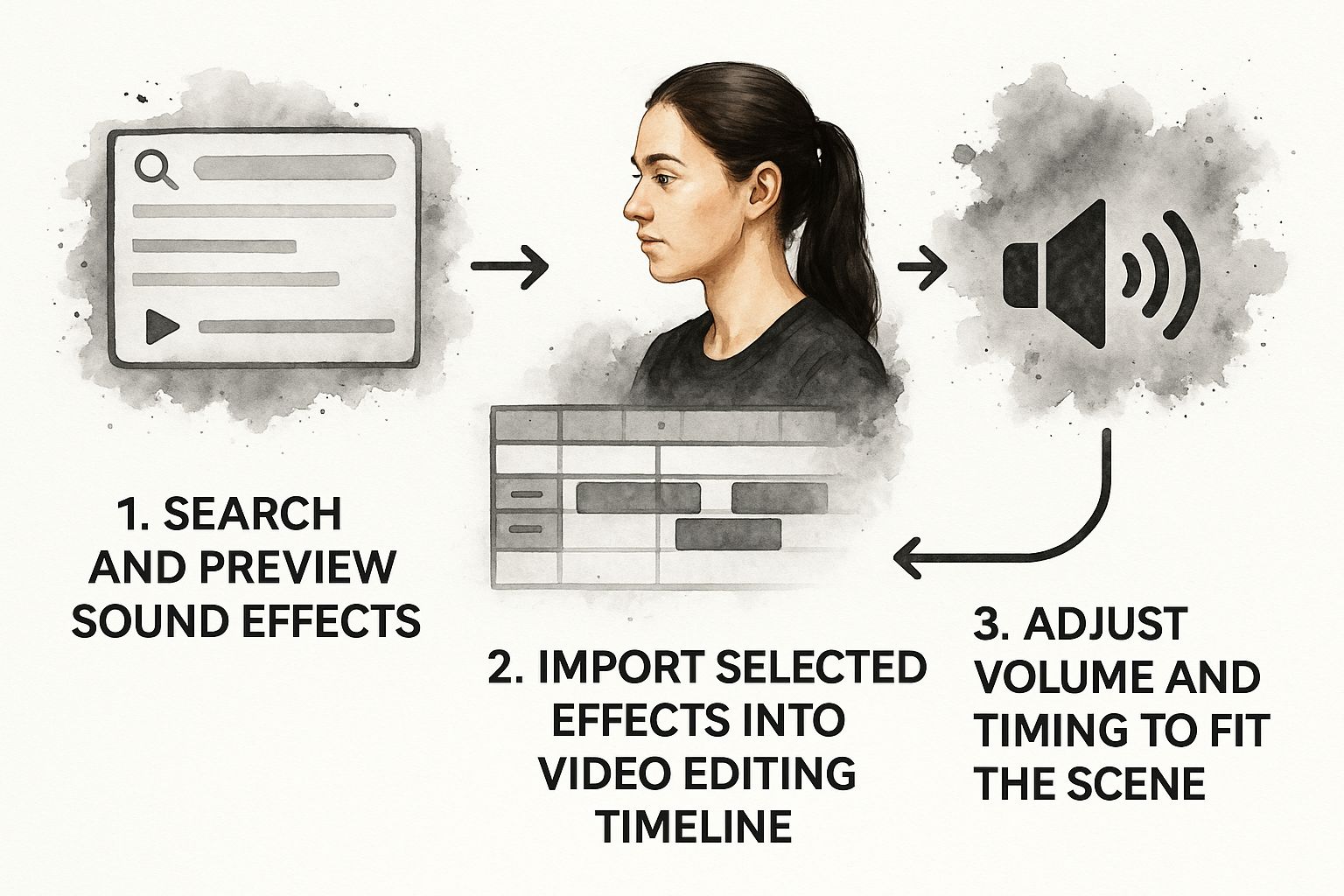
It's easy to get lost in the visuals, but great video editing is as much about what you hear as what you see. The best sound effects for video editing aren't just there to fill silence. They're a vital part of the storytelling toolkit, the very thing that makes your content feel immersive, professional, and genuinely moving.
Think of sound as the secret ingredient that turns a decent video into a memorable one.
We’ve all seen it: a beautiful 4K video that falls completely flat because the audio is an afterthought. It just feels cheap. Sound is the invisible hand that gives your visuals weight, texture, and emotional punch. It's the difference between merely watching an action and truly feeling it.
Picture a fight scene. With the sound off, it’s just a bunch of people moving around. But layer in the sharp whoosh of a missed punch, the sickening thud of a hit landing, and the clatter of a chair being knocked over—suddenly, you’re right there in the middle of it all. This psychological connection is what elevates amateur content to something that feels professional.
Beyond just adding realism, sound effects are your way of directing the audience's focus. A subtle ding can pull their eyes to a new message on a character's phone. A slowly building atmospheric tone can create a sense of dread right before a jump scare.
The right sound effect doesn’t just complement the visuals; it injects a layer of information and feeling that visuals alone can't touch. It tells the viewer how they should feel about what’s happening on screen.
This idea of using audio to shape an experience is a fundamental part of the craft. To dig deeper into these core concepts, you can explore our guide on what is audio production.
The secret is out: high-quality audio is non-negotiable. As more and more people create video content, audience expectations for production value have skyrocketed. In fact, the number of people paying for video editing software is projected to hit around 48.22 million by 2025.
This explosion in creators means everyone is looking for an edge to make their videos stand out. As you can find in these video editing statistics on TripleAReview.com, investing in professional-grade tools—especially for sound design—is no longer a luxury but a necessity.
Let's break down how different sound effects contribute to the final product.
The table below summarizes the key types of sound effects and the specific job each one does to enhance the viewing experience.
| Effect Type | Primary Role | Example Usage |
|---|---|---|
| Foley | Adds realism and physicality to human actions. | The rustle of clothing, footsteps on gravel, a key turning in a lock. |
| Ambience | Establishes the environment and setting's mood. | The distant sound of city traffic, birds chirping in a forest, the low hum of an office. |
| Hard Effects | Synchronized sounds for specific, visible events. | A door slam, a gunshot, a car engine starting, a phone ringing. |
| UI/UX Sounds | Provides feedback for digital or abstract interactions. | A "swoosh" for a transition, a "click" on a button, a notification "ping". |

Staring at a massive library of audio files can feel like trying to find a needle in a haystack. It’s easy to get bogged down by technical jargon. The trick is to stop thinking about what a sound is and start focusing on what it does. A true sound designer approaches their toolkit based on the job each sound needs to perform, turning a guessing game into a series of strategic choices.
A well-stocked toolkit of sound effects for video editing really comes down to four practical pillars. Each one has a specific job to do when it comes to bringing your story to life.
First up, we have Foley. This is the art of realism. Foley sounds are the subtle, everyday noises that make actions on screen feel tangible and real. They’re the sounds of life, carefully recreated and synchronized to the visuals.
Think about a character walking across a room. Without Foley, they just glide in eerie silence, which instantly feels fake. But add the soft scuff of shoes on a hardwood floor, the slight rustle of a jacket, and the faint click of a doorknob, and the scene suddenly has weight. Your character feels like they’re actually in the space. These are the sounds viewers don’t consciously register, but they’d definitely feel their absence.
While Foley handles the specific actions, ambiance paints the bigger picture. These are the background sounds that establish a location and set a mood. They tell the audience where they are without you ever needing to show a sign or write a single word of dialogue.
It’s basically the audio version of set dressing. Is your scene taking place on a chaotic city street or in a peaceful forest?
Ambiance is the foundation of your soundscape. It’s the canvas you layer everything else onto, creating a believable and immersive world for your story to unfold in.
Transitions are the sonic glue that holds your edit together. These sounds are designed to smooth over cuts, guiding the viewer from one shot or scene to the next. Instead of a jarring jump cut, a well-placed transition sound signals that a change is coming.
Some go-to transitional sounds include:
Using these kinds of effects is what makes an edit feel intentional and professional, not random.
Finally, we have accents. Think of these as the exclamation points of your video's soundtrack. They are short, distinct sounds that draw immediate attention to a specific moment, action, or piece of on-screen information.
You hear them all the time: a quick ping when a text message appears, a dramatic hit when a title card slams onto the screen, or a satisfying click when a button is pressed in a user interface. These tiny but powerful sounds provide clarity and add punch, making sure your most important moments land with the viewer.

Okay, so you know what sounds your video needs. Now comes the real challenge: actually finding them. The hunt for the perfect sound effects for video editing can feel like digging for a needle in a haystack, but with the right strategy, you can save a ton of time and stay on budget. Your best approach really depends on your project's scope, your budget, and just how custom you need the audio to be.
The great news? The demand for top-notch audio has fueled a massive market. The global sound effects services industry was valued at roughly $2.5 billion in 2023 and is expected to almost double by 2032. For creators like us, that growth means more choices and better quality than ever before. You can get a closer look at this trend with these sound effects market insights on DataIntelo.com.
For most working editors, subscription libraries are the go-to solution. Think of services like Artlist, Epidemic Sound, and Envato Elements. They offer enormous, well-curated collections of professional-grade sounds.
If you're creating video content on a regular basis, a subscription is almost always a smart investment. The time you save and the confidence you get from clear licensing easily pays for the monthly or annual cost.
If your budget is zero, free resources are your best friend. Websites like Pixabay, Freesound, and ZapSplat host thousands of effects at no cost. But—and this is a big but—you have to read the fine print.
When you're using free sounds, the license is everything. Always, always check if a sound is cleared for commercial use, if you need to give credit (attribution), or if it's under a Creative Commons (CC0) license, which essentially means no strings attached.
You can uncover some absolute gems in these archives, but you should also be ready to spend more time sifting through files of varying quality. A good habit is to start building your own personal library of your best finds. It'll massively speed up your audio post-production workflow down the road.
There's a new player in town when it comes to sourcing sound effects for video editing: AI generation. Platforms like SFX Engine let you create completely custom sounds just by typing what you want. It's a game-changer.
This approach gives you a level of creative freedom that was previously unthinkable. Instead of spending hours searching for the perfect "light rain tapping on a tin roof," you can generate that exact sound yourself. You can tweak its intensity, character, and tone until it fits your scene perfectly.
This completely bypasses the hunt for the "right" file because you create it. The sound is guaranteed to be unique to your project and totally royalty-free. It's an amazing solution for those very specific, hard-to-find sounds or for any creator who wants to build a truly signature audio style.

For any creator, few things are as dreaded as a copyright strike. Diving into audio licensing can feel like you’re trying to decipher a dense legal document, but it’s actually more straightforward than it appears. Just think of a license as a permission slip that clearly spells out how you can—and can’t—use a sound effect in your video edits. Taking a moment to understand these terms is your best defense against major headaches down the road.
One of the most common terms you'll run into is Royalty-Free. This one trips a lot of people up. It doesn't mean the sound is free of charge. It simply means you don’t have to pay ongoing fees, or "royalties," every time someone watches your video. You usually pay once, often as part of a subscription, for the right to use that sound in your projects forever.
Beyond the standard royalty-free model, you’ll encounter a few other license types, especially when sourcing sounds from free websites. Knowing what these mean before you download is essential.
Creative Commons (CC): This isn't a single license but a whole family of them. The most open is CC0 (Public Domain), which lets you use the sound for anything you want, no credit needed. Other CC licenses might require you to credit the artist (Attribution) or forbid you from using the sound in commercial projects.
Commercial Use: This is the big one. If you plan to make any money from your video—through YouTube ads, brand deals, or selling a product—you need this permission. Always double-check that a sound's license specifically allows for commercial use.
A license isn't just a suggestion; it's a binding agreement. Ignoring it can jeopardize your content and your channel. Taking thirty seconds to check the terms before you download is one of the smartest habits you can build.
This is where AI sound generators like SFX Engine really shine. Every sound you generate is made just for you and comes with a clear commercial license from the get-go. This completely sidesteps all the ambiguity and risk, arming you with unique, high-quality sound effects for video editing that are 100% worry-free. You get total creative freedom without any of the legal guesswork.
Great sound design isn't a happy accident. It’s not about just dragging a bunch of audio files onto your timeline and crossing your fingers. Experienced editors follow a deliberate, structured workflow to build a rich sonic world from scratch, turning a jumble of clips into a polished, immersive soundscape.
It all starts with getting organized. Seriously. Before you even think about your timeline, gather and sort all your audio assets. In your editing software, create dedicated bins or folders for different sound categories—things like Foley, Ambiance, and Transitions. This little bit of housekeeping upfront will save you a massive headache later and keep the creative process flowing smoothly.
Once you’re organized, it's time to build your soundscape layer by layer. I like to think of it like painting. You don't start with the tiny details; you begin with the broad strokes of the background and slowly add more definition.
First, lay down your ambiance track. This is the foundation of your scene's sound, establishing the environment. Is it the low hum of a busy city street? The gentle rustle of leaves in a forest? This track should run consistently under the entire scene, creating a sonic bed for everything else to sit on.
Next, you'll want to add your specific, action-oriented sound effects. These are the sounds that need to be perfectly timed with on-screen events—a closing door, a ringing phone, a shattering glass. Precision is everything here. If the timing is off by even a few frames, it can feel jarring and pull the viewer out of the experience. We have a whole guide on getting this sync perfect, which you can read here: https://sfxengine.com/blog/how-to-sync-audio-with-video.

As you can see, a solid workflow is really a simple, repeatable process: you find the right sound, bring it into your project, and then fine-tune it until it feels right.
With your core sounds in place, the real magic happens in the mix. This is where you adjust all the individual audio elements so they feel like they genuinely belong together in the same space. It's often the subtle adjustments that make the biggest difference.
Mastering a few key audio mixing techniques is essential for making your sound effects blend naturally. The table below breaks down some of the most common adjustments you'll be making.
| Technique | What It Does | When to Use It |
|---|---|---|
| Volume Automation | Dynamically changes the volume of a clip over time using keyframes. | To make a sound get louder as it approaches the camera or quieter as it moves away. Great for footsteps or passing cars. |
| Panning | Positions a sound in the left, right, or center of the stereo field. | To match the sound's position to its on-screen location. A car driving from left to right should have its sound follow. |
| EQ (Equalization) | Boosts or cuts specific frequencies to change the character of a sound. | To make a sound feel "muffled" as if it's coming from another room, or to remove a harsh high-frequency hiss. |
| Reverb | Adds echo and spatial character to a sound, making it feel like it's in a real environment. | To place a "dry" sound effect into a specific space, like making a voice echo in a large hall or a footstep sound like it's on a tile floor. |
These techniques are your toolkit for creating a believable audio experience. A dry sound effect pulled straight from a library often feels disconnected, but adding a touch of the right reverb can instantly glue it to the scene.
Your ultimate goal in mixing is to find balance. No single sound should be so loud or out of place that it's distracting. Instead, every effect should work together to support the story, always ensuring that dialogue and key action sounds have the priority they need.
Of course, a professional workflow extends beyond just audio. For those working with aerial shots, this comprehensive guide to drone video editing software provides fantastic insights on integrating stunning visuals with compelling sound design. When both sight and sound work in harmony, the final product is so much more powerful.
Once you've nailed the basics of syncing sound to action, the real fun begins. This is where sound design shifts from a technical task to a true art form. It’s your opportunity to play around, bend the rules, and forge an audio style that makes your videos instantly recognizable. These creative flourishes are what elevate a good video into a great one.
Think about how you build suspense in a thriller. It’s rarely about a single, loud jump scare. More often, it's a careful construction of subtle, almost subliminal sounds—a low, humming drone, the faint tick-tock of a clock, or even a normal sound played in reverse to feel just wrong. These elements get under the viewer's skin, creating a palpable sense of unease long before anything actually happens on screen.
Sound can tell a story that your visuals can't, or even contradict them on purpose. This is the power of adding emotional subtext with audio. Imagine a scene where a character is smiling and laughing, but underneath it all, you hear a faint, slightly discordant chime. Suddenly, that happiness feels hollow and fake, hinting at a deeper, hidden turmoil.
You can also use sound to manipulate our perception of size and power. Pitch-shifting is a classic trick for this.
The most powerful sound design often lives in the gap between what we see and what we feel. It’s about using audio to hint at deeper truths, foreshadow what's to come, or purposefully play with the audience's expectations.
Sometimes, the most effective sound is no sound at all. Think about a chaotic action sequence—a flurry of explosions, gunfire, and shouting. If you suddenly cut all audio to absolute silence for a second or two, the effect is jarring and incredibly dramatic. This abrupt void forces the audience to lean in, amplifying the shock or emotional gravity of whatever comes next. Silence is the ultimate contrast, making the sounds that eventually return hit that much harder.
The industry is taking notice of this creative push. The market for sound effects software, which is essential for sourcing sound effects for video editing, is expected to jump from $2.82 billion in 2025 to $5.22 billion by 2033. This boom isn't just about numbers; it shows a real demand for more sophisticated tools that allow editors to build these kinds of detailed soundscapes. You can dig deeper into this trend with these sound effects software market findings on GlobalGrowthInsights.com.
As you get your hands dirty in the editing timeline, some practical questions about sound effects always seem to come up. Getting straight answers quickly can be a real project-saver, helping you make smarter creative calls without breaking your flow. Let's dig into some of the most common questions editors have.
Honestly, there’s no golden number. The real goal is to be intentional, not just to fill silence. A good rule of thumb is to use SFX to support key actions on screen, build a believable environment, and give emotional moments that extra punch. The focus should always be on sounds that serve the story.
Here's a little trick I use: close your eyes and just listen to your timeline. Does the audio alone tell a compelling story? If so, you're in a great spot. Piling on too many effects can quickly make your mix sound messy and amateurish. When in doubt, remember that less is often more.
Good sound design is all about clarity and impact. Every single sound should have a reason for being there, whether it's grounding the scene in reality or making an emotion feel bigger. If a sound doesn't help the story, it's just noise.
The short and simple answer is a hard no. Sound effects from big commercial projects—films, TV shows, video games—are locked down by some serious copyright laws. Using them without getting explicit permission is a form of infringement, and the fallout can be pretty severe.
You're opening yourself up to risks like:
It’s so much safer and more professional to stick with dedicated SFX libraries that offer clear, straightforward licensing.
This is a great question. While they're both crucial parts of your audio mix, sound effects and music do very different jobs. Music is all about setting the big-picture mood and emotional tone. It usually runs in the background, subtly telling the audience how they should feel about what they're watching.
Sound effects, or SFX, are the opposite. They are almost always short, specific sounds tied directly to an action or event on screen—a door creaking shut, fingers tapping on a keyboard, or a magical zing. Music creates the atmosphere, but SFX creates the immersion by connecting what you hear to what you see. They have to work together to create a truly complete audio experience.
Tired of endlessly searching for the right sound? Stop hunting and start creating. With SFX Engine, you can generate custom, high-quality, and completely royalty-free sound effects just by typing a prompt. Get the exact audio your project needs, every single time. Try SFX Engine for free today.